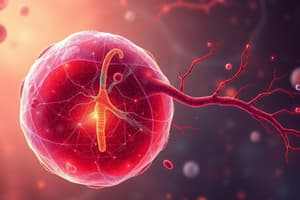Podcast
Questions and Answers
What primarily contributes to the development of chronic bronchitis?
What primarily contributes to the development of chronic bronchitis?
- Excessive exercise
- Genetic predisposition
- Smoking or pollution (correct)
- Viral infections
Which symptom is NOT typically associated with emphysema?
Which symptom is NOT typically associated with emphysema?
- Difficulty exhaling
- Persistent cough (correct)
- Chest discomfort
- Shortness of breath
What is a major health risk associated with nicotine consumption?
What is a major health risk associated with nicotine consumption?
- Increased heart rate (correct)
- Reduced lung capacity
- Decreased addiction potential
- Increased oxygen levels
What impact does tar have on lung health?
What impact does tar have on lung health?
How does second-hand smoke affect children?
How does second-hand smoke affect children?
Which measure is NOT included in smoking legislation in South Africa?
Which measure is NOT included in smoking legislation in South Africa?
Why is artificial respiration important?
Why is artificial respiration important?
What is a health impact of carbon monoxide exposure?
What is a health impact of carbon monoxide exposure?
What is the primary function of the gills in bony fish?
What is the primary function of the gills in bony fish?
How do earthworms perform gas exchange?
How do earthworms perform gas exchange?
What structural feature helps insects like locusts with gas exchange?
What structural feature helps insects like locusts with gas exchange?
What is primarily responsible for transporting oxygen in the blood to the tissues of the body?
What is primarily responsible for transporting oxygen in the blood to the tissues of the body?
What helps maintain a steep concentration gradient for gas exchange in animals?
What helps maintain a steep concentration gradient for gas exchange in animals?
During gaseous exchange in the alveoli, oxygen diffuses from the air to the blood due to what process?
During gaseous exchange in the alveoli, oxygen diffuses from the air to the blood due to what process?
Which of the following adaptations is characteristic of terrestrial animals regarding gas exchange?
Which of the following adaptations is characteristic of terrestrial animals regarding gas exchange?
What happens to carbon dioxide in the blood when it reaches the alveoli?
What happens to carbon dioxide in the blood when it reaches the alveoli?
What role does the operculum play in fish?
What role does the operculum play in fish?
How do cells in body tissues take up oxygen from the blood?
How do cells in body tissues take up oxygen from the blood?
What is the function of stomata in plants?
What is the function of stomata in plants?
How do aquatic organisms primarily achieve gas exchange?
How do aquatic organisms primarily achieve gas exchange?
What is a potential consequence of high altitudes on gaseous exchange?
What is a potential consequence of high altitudes on gaseous exchange?
In the body, what role does haemoglobin play in respiration?
In the body, what role does haemoglobin play in respiration?
What is the effect of smoking on respiratory function?
What is the effect of smoking on respiratory function?
What leads to oxygen debt in muscle cells during intense exercise?
What leads to oxygen debt in muscle cells during intense exercise?
Flashcards
Gaseous exchange in alveoli
Gaseous exchange in alveoli
Oxygen diffuses from the alveoli into the blood capillaries, and carbon dioxide diffuses from the blood into the alveoli.
Oxygen transport in blood
Oxygen transport in blood
Most oxygen combines with haemoglobin in red blood cells to form oxyhaemoglobin for transport to the tissues.
Gaseous exchange in tissues
Gaseous exchange in tissues
Oxygen diffuses from the blood into cells, while carbon dioxide diffuses from cells into the blood.
Deoxygenated blood
Deoxygenated blood
Signup and view all the flashcards
Oxyhaemoglobin
Oxyhaemoglobin
Signup and view all the flashcards
Concentration gradient
Concentration gradient
Signup and view all the flashcards
Unicellular Gas Exchange
Unicellular Gas Exchange
Signup and view all the flashcards
Earthworm Gas Exchange
Earthworm Gas Exchange
Signup and view all the flashcards
Fish Gills
Fish Gills
Signup and view all the flashcards
Locust Tracheal System
Locust Tracheal System
Signup and view all the flashcards
Terrestrial Gas Exchange
Terrestrial Gas Exchange
Signup and view all the flashcards
Plant Gas Exchange
Plant Gas Exchange
Signup and view all the flashcards
Concentration Gradient
Concentration Gradient
Signup and view all the flashcards
Ventilation (Animals)
Ventilation (Animals)
Signup and view all the flashcards
Protection from Water Loss
Protection from Water Loss
Signup and view all the flashcards
Chronic Bronchitis
Chronic Bronchitis
Signup and view all the flashcards
Emphysema
Emphysema
Signup and view all the flashcards
Lung Cancer
Lung Cancer
Signup and view all the flashcards
Nicotine
Nicotine
Signup and view all the flashcards
Tar
Tar
Signup and view all the flashcards
Carbon Monoxide
Carbon Monoxide
Signup and view all the flashcards
Secondhand Smoke/Passive Smoking
Secondhand Smoke/Passive Smoking
Signup and view all the flashcards
Smoking Legislation
Smoking Legislation
Signup and view all the flashcards
Artificial Respiration
Artificial Respiration
Signup and view all the flashcards
Mouth-to-Mouth Resuscitation
Mouth-to-Mouth Resuscitation
Signup and view all the flashcards
Study Notes
Gaseous Exchange in Living Organisms
- Aerobic respiration requires a constant supply of oxygen and expulsion of carbon dioxide.
- Organisms have specialized gas exchange organs (like lungs or gills) for this process.
- Gas exchange occurs by diffusion, moving molecules from high to low concentration.
- Cellular respiration is the process of breaking down food molecules to release energy.
- Breathing involves moving air in and out, necessary for gas exchange.
- Diffusion is the movement of molecules from high to low concentration.
- Surface area-to-volume ratio significantly impacts gas exchange. Small organisms have a larger ratio, allowing for diffusion across their body surface, whereas larger organisms need specialised structures.
- Specialized structures like gills and lungs provide large surface areas for efficient gas exchange in larger organisms.
Key Concepts
- Cellular respiration: A chemical process in cells that breaks down food molecules to release energy.
- Breathing: The physical process of moving oxygen-rich air into the lungs and expelling carbon dioxide-rich air.
- Gas exchange: The process of oxygen and carbon dioxide diffusing across a surface or membrane.
Specialized Structures in Larger Organisms
- Gas exchange organs (like gills or lungs) with specialized surfaces offer a large surface area.
Gaseous Exchange In Specific Organisms
- Earthworms: Diffuse gases across their thin, permeable body surface, kept moist by mucus.
- Locusts: Utilize a tracheal system and spiracles for gas exchange, regulated via movements.
- Bony Fish: The gills, containing filaments and lamellae, provide a large surface area for efficient water-based gas exchange.
- Dicotyledonous Plants: Gas exchange mainly occurs through stomata, controlled by guard cells, within the leaves.
- Mammals: Alveoli in the lungs facilitate oxygen and carbon dioxide exchange.
The Breathing (Ventilation) System
- The nose leads to nasal passages.
- The nasal cavity contains conchae to increase surface area and warm/filter air.
- The pharynx connects the nasal cavity to the larynx (voice box).
- The larynx contains vocal cords.
- The epiglottis prevents food from entering the trachea.
- Bronchi branch from the trachea into each lung.
- Bronchioles are smaller branches of the bronchi, within the lungs.
- Alveoli are tiny air sacs within the lungs that facilitate gas exchange (with a network of capillaries).
- Cilia sweep mucus and trapped particles away from the lungs.
- The two lungs are spongy organs in the chest cavity. They each have multiple lobes.
- The alveoli have a large surface area for gas exchange.
Gaseous Exchange and Transport of Gases
- Blood brings deoxygenated blood to the alveoli.
- Oxygen diffuses from the alveoli into the blood.
- Oxygen binds to haemoglobin in red blood cells, becoming oxyhemoglobin.
- Oxygen is transported to body tissues.
- Carbon dioxide diffuses into the blood from body tissues (it's a byproduct of cellular activities)
- Carbon dioxide is transported in blood in various forms.
Transport of Carbon Dioxide
- Some CO2 dissolves in the blood plasma.
- Some binds to haemoglobin.
- Most is carried as bicarbonate ions.
- CO2 diffuses from the blood to the alveoli for exhalation.
Gaseous Exchange: A Detailed Overview
- Gaseous exchange is the process of obtaining oxygen for respiration and expelling carbon dioxide.
- It primarily happens through diffusion across respiratory surfaces from high to low concentrations.
Adaptations for Gas Exchange in Different Organisms
- Unicellular organisms use direct diffusion.
- Small multicellular organisms use their moist skin.
- Fish use gills with lamellae.
- Insects use a tracheal system.
- Plants use stomata.
- Mammals use lungs with alveoli.
Regulation of Breathing and Homeostasis
- The medulla oblongata controls breathing rates based on carbon dioxide levels.
- Breathing rates adjust to exercise and altitude.
Measurement of Lung Capacity
- Spirometers measure vital capacity and tidal volume.
Effects of Physical Activity on Breathing
- Breathing rate and depth increase during exercise.
Common Respiratory Diseases
- Tuberculosis
- Asthma
- Hay Fever
- Bronchitis
- Emphysema
Effects of Smoking on Health
- Nicotine, tar, and carbon monoxide negatively impact health.
Studying That Suits You
Use AI to generate personalized quizzes and flashcards to suit your learning preferences.




